Everyone should have a few solid fish recipes in their repertoire. Especially in the summertime. Summer is all about light, but flavorful meals that don’t require you to spend too much time in the kitchen (although, I don’t typically complain unless there’s cleaning involved). Bonus points if there’s a grill involved. Here’s a flavorful fish recipe that you absolutely should make this season.
Grilling Fish in Corn Husks
Grilling fish in corn husks is my new favorite activity. See my former favorite activities: roasting garlic and browning butter, which have taken a back seat to the perfection that comes with grilling or broiling fish in corn husks. Think fish en papillote, but the grilled version. The corn husks help retain the moisture while the fish cooks under high heat.
Which Fish to Grill?
I love halibut or any firm-fleshed fish for this cooking method, like grouper or haddock. I would not recommend using a super tender and flaky fish, like cod, for this method.
Halibut is medium-firm, white fish with a mild flavor (meaning, it doesn’t have a strong or fishy taste). Its firmness keeps it from falling apart while grilling and its mildness allows it to soak up the flavors you pair with it. Halibut also has a low oil content, so halibut can dry out fairly quickly if left under heat for too long. Because halibut is lower in oil (unlike salmon and mahi mahi), it pairs really well with the spiced lime butter and doesn’t result in an oily dish. You’ve probably had this happen with salmon—salmon releases its own oils when cooked, so adding oil and/or butter can make the fish overly oily.
Cooking with Corn Husks
I used dried corn husks for this recipe, which I found in the international section of my local grocery store. They sell a large bag for a few dollars or so and the bag is still over half full after preparing this recipe. Plenty of corn husks to go around and definitely enough to make this recipe several times.
The first step is soaking the corn husks (and kitchen twine) that you’re using to wrap around the fish. I used a large mixing bowl to soak the husks and twine in cool water. You want to ensure that the husks are fully submerged during the soaking time, as dried corn husks are light and tend to float to the top. I placed a saucer on top to keep the husk sheets from floating to the top. You’ll want to soak the corn husks for at least 30 minutes or overnight, which will keep them from burning up under direct heat.
You’ll need about 2 to 3 corn husk sheets per fish fillet, depending on the length and thickness of your fillets. I always soak some extra sheets for mistakes. I’d hate to wait run out of soaked corn husk sheets while in the midst of cooking.
I haven’t yet made this recipe with fresh corn husks or banana leaves. The use of fresh husks requires less or no soaking, since they’re more pliable. I would at least soak them in water for a few minutes before wrapping the fillets.
No Corn Husks? No Problem.
The husks are great for presentation, but not absolutely necessary if you don’t have any readily available. You can use parchment paper and prepare this recipe in the oven. Do NOT grill the fish in parchment paper over a direct flame. Corn husks can help with adding a smoky flavor and, if you’re using fresh ones, they will infuse some of the corn’s flavor into the fish.
Spiced Lime Compound Butter
Let me start by saying that, the fresher your ingredients, the better the butter. The spiced lime butter is a compound butter with garlic, lime juice, lime zest, cumin, freshly ground coriander, and black pepper.
First, I used whole coriander seeds and crushed them in a mortar and pestle before measuring and adding to the butter. I crush the coriander seeds using a mortar and pestle. The fragrance begins to release as soon as you start crushing them. Freshly ground coriander is fragrant and way more flavorful than the pre-ground coriander stuff in the spice bottle. Perfectly fine to use though if you can’t get your hands on the whole seed.
Wrapping the Fish
To wrap the halibut, you’re basically going to make little “packets” covering the halibut fillets in corn huss with openings for air to escape.
— Wrap the fish fillets by laying one or two overlapping wet corn husk sheets flat on a flat surface, like a baking sheet pan.
— Place one fillet on the layer corn husk sheets, skin-side down.
— Season with salt and brush and/or coat with the spiced lime butter and top with small spoonfuls of chopped red onion and fresh cilantro.
— Lay another wet corn husk sheet on top of the seasoned fillet.
— Working with on end at a time, bunch up the end of the corn husk sheets and tie them together with kitchen twine, so that the fish is in a little boat-shaped packet. If you pick up the packet at the ends, the sides of packet should gap open slightly. This is good, so that hot air can escape the fish packet while cooking.
Transfer the packets to a large, preheated cast iron skillet or a broiling pan that withstand high temperatures under the broiler. If cooking in the oven, before broiling, you may want to remove the top corn husk layer to go for that “grilled” look and to achieve slightly crisp edges.
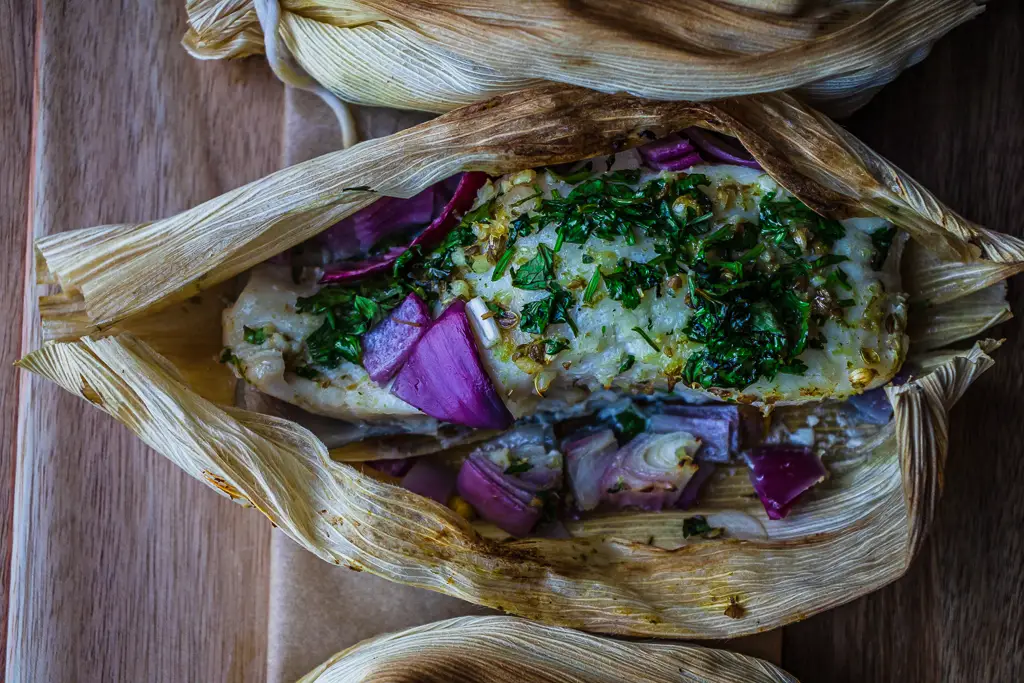

Grilled Halibut in Corn Husks with Spiced Lime Butter
You only need a handful of fresh ingredients and some good quality halibut fillets to make these grilled fish packets your summertime staple. The halibut is coated with a spiced lime compound butter and then wrapped and grilled or broiled in soaked corn husks.
Ingredients
- About 12 dried corn husks (2 to 3 per fillet)
- Kitchen twine (about 6 inches per fillet)
- 6 tablespoons butter, room temperature
- 3 cloves garlic, minced
- 1 teaspoon coriander seeds, freshly ground
- ½ teaspoon ground cumin
- Juice and zest of half a lime
- Several turns of freshly ground black pepper
- 1 ½ to 2 pounds halibut, skin on (divided into 4 fillets)
- Several pinches of kosher or sea salt
- 1 red onion, finely chopped or minced
- ½ cup fresh cilantro, finely chopped
Instructions
- For at least 30 minutes (or overnight), soak the dried corn husks and kitchen twine in water.
- Make the Spiced Lime Butter: In a bowl, combine butter, garlic, coriander, cumin, lime juice and zest, and black pepper. Microwave for about 10 to 15 seconds to melt the butter. Set aside while you prepare the fish packets.
- If using the Bake & Broil method, place a large cast iron skillet or broiler-safe sheet pan in the oven while it preheats to 425 degrees F. Remove the corn husks sheets from the water and pat dry so they’re not dripping with water but still completely damp. Working in batches, coat each fillet in butter (or brush the tops) and place on one or two overlapping sheets of corn husk. Season with a pinch of kosher or sea salt and top with a large pinch of chopped onions and cilantro. Tie the ends with kitchen twine.
- To Bake & Broil: Transfer the wrapped halibut fillets to a large, pre-heated cast iron skillet. Bake at 425 degrees for about 12 to 14 minutes and then finish in the broiler at 500 degrees for another 2 to 3 minutes or until the halibut fillets are done – they should be opaque white and flaky. The halibut fillets are done once they reach an internal temperature of 145 degrees F.
- To Grill: Place the wrapped halibut fillets on the grill directly over the fire and grill for about 5 to 7 minutes and close the lid. Flip and close the lid, grilling for another 5 to 7 minutes until the halibut fillets are done – they should be opaque white and flaky. The halibut fillets are done once they reach an internal temperature of 145 degrees F.
- Remove the wrapped fillets from the heat and serve the fish in the husks removing only the top to reveal the fish.
Notes
• Halibut is medium-firm, white fish with a mild flavor. Any firm-fleshed fish, like haddock or grouper, would work for this recipe.
• You’ll need about 2 to 3 corn husk sheets per fish fillet, depending on the length and thickness of your fillets. I always soak some extra sheets for mistakes. You can also use fresh corn husks by shucking corn, removing the silk, and using the fresh green husks.
• The corn husks can add flavor to the fish and are perfect for presentation, but if you can’t get your hands on any, you can use parchment paper and prepare this recipe in the oven and broiler. You can use the grill, but I would NOT grill the fish in parchment paper over a direct flame. The paper will burn right up. Remember that most parchment paper can only withstand temperatures up to about 425 degrees and perhaps only a few minutes under higher heat.
• I served this fish with charred chimichurri corn. Sticking with the “corn theme” will never fail with this dish, but pretty much any grilled vegetable will pair well.
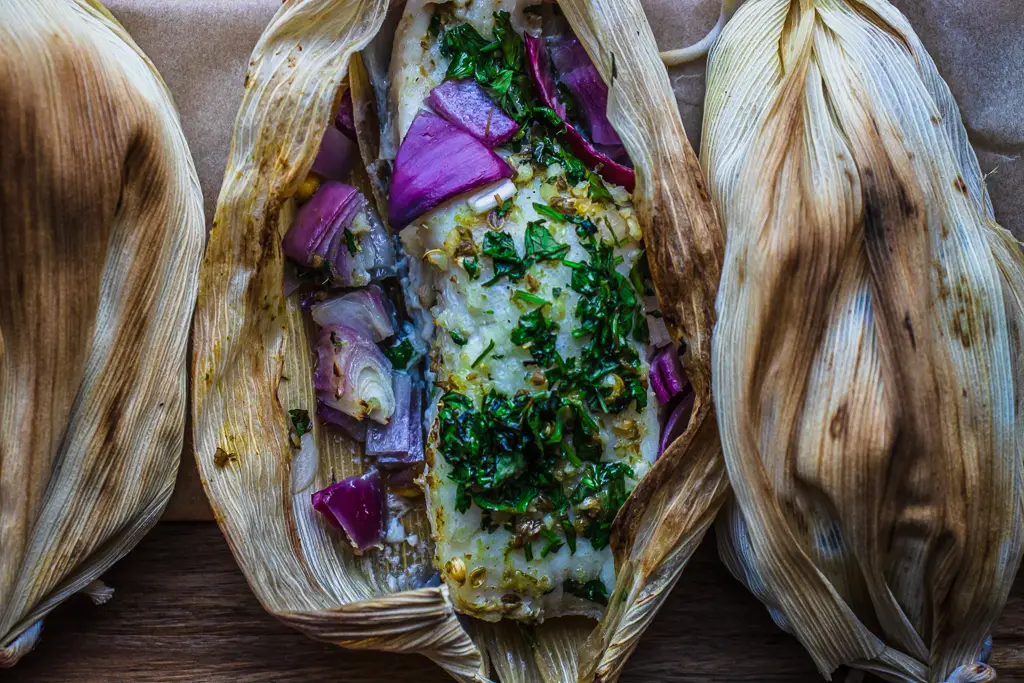
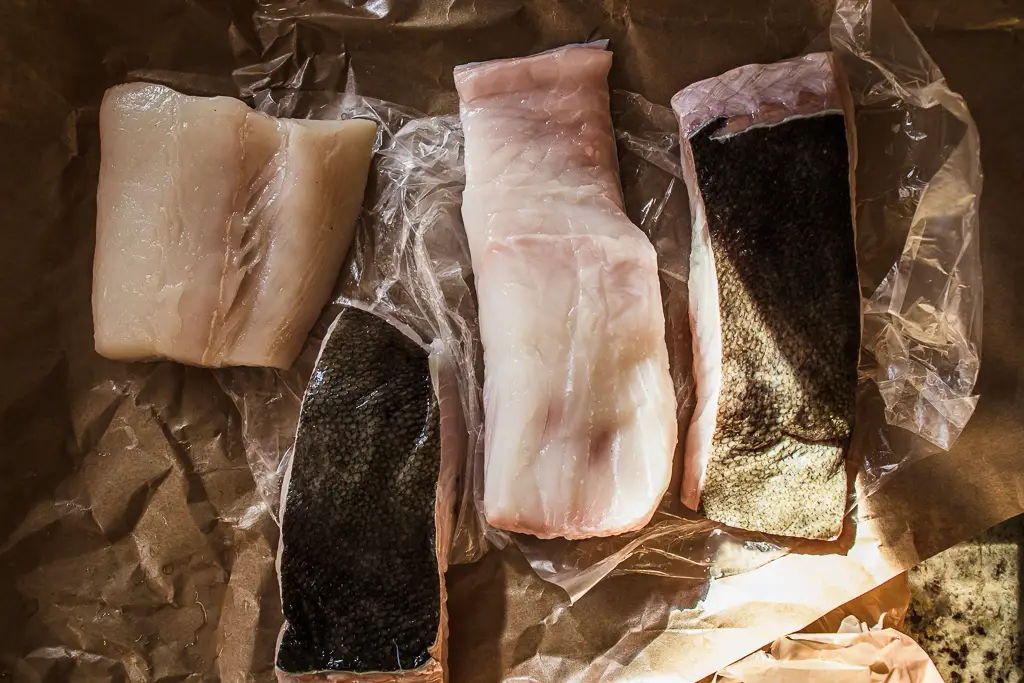
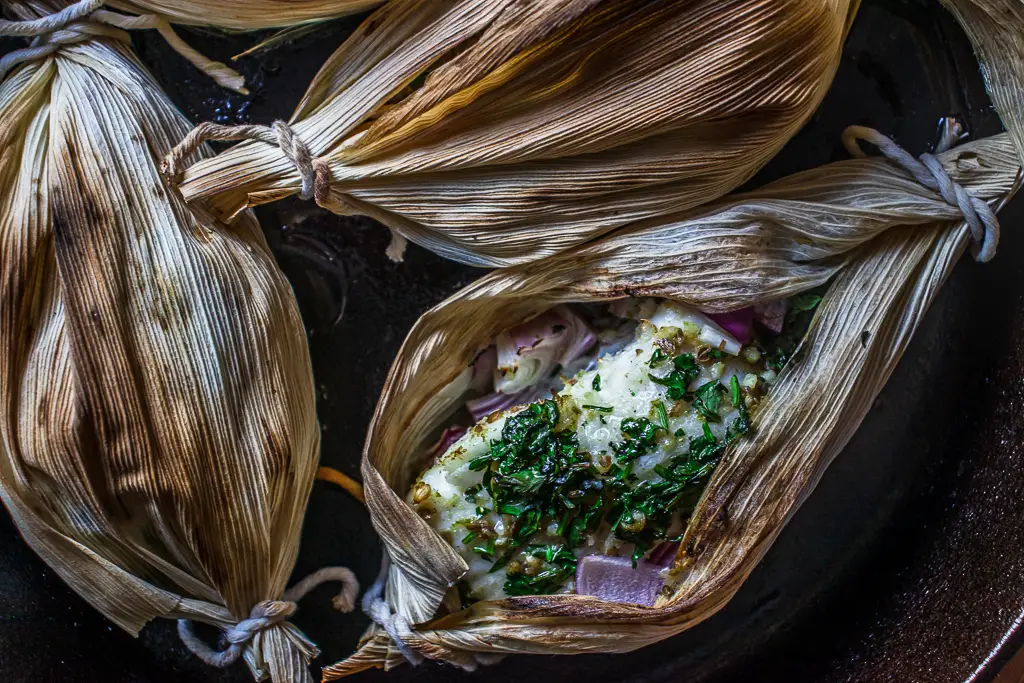

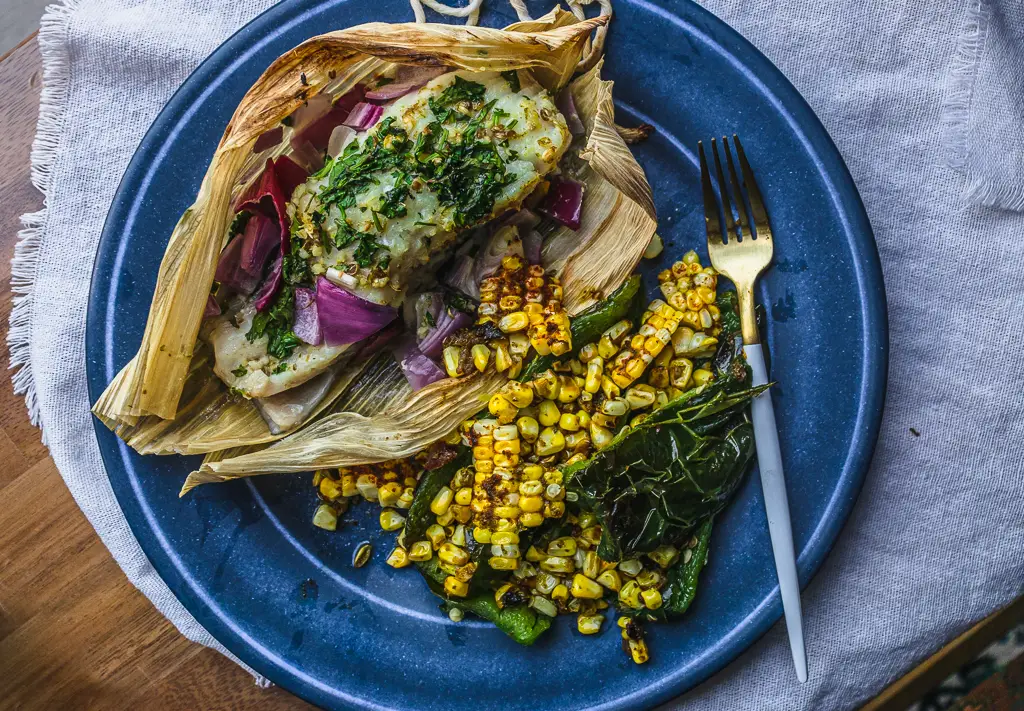
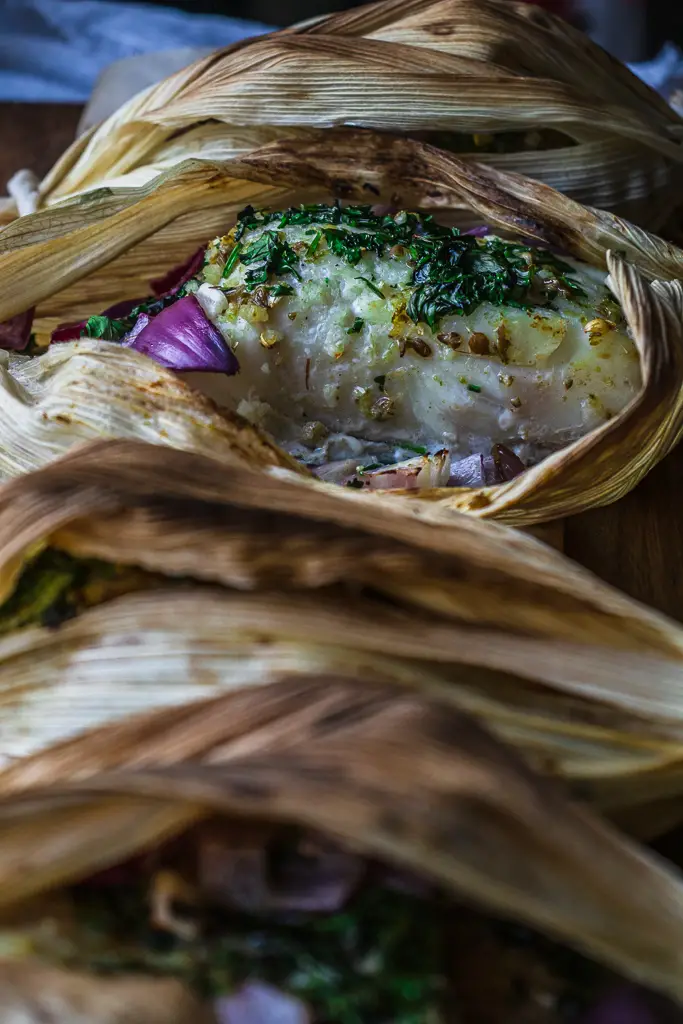
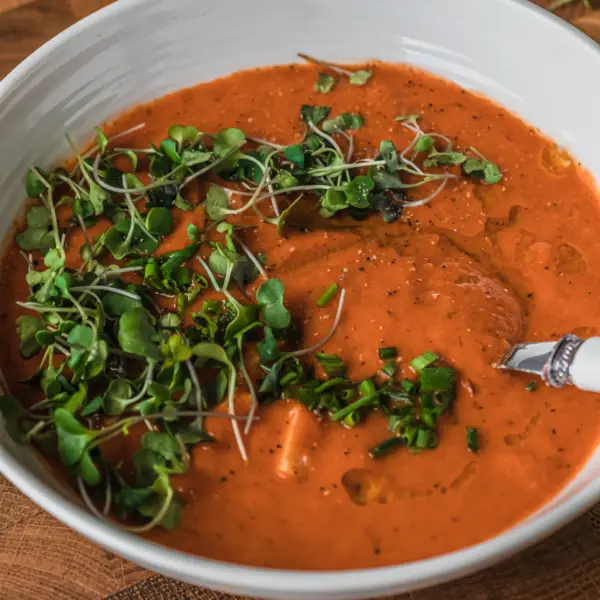
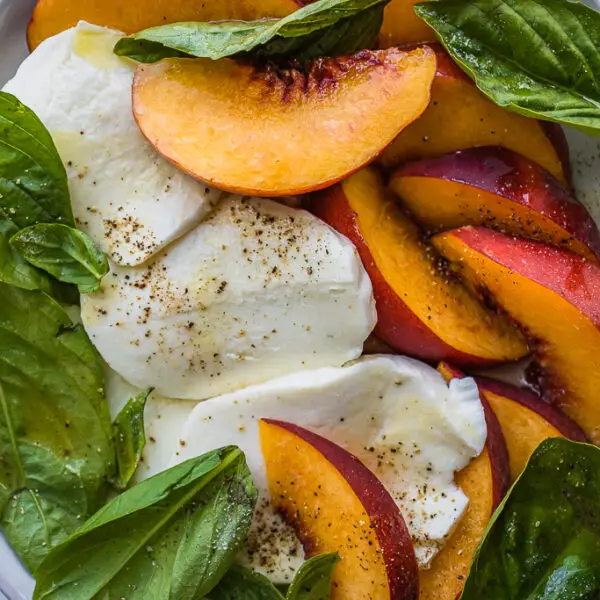


Leave a Reply